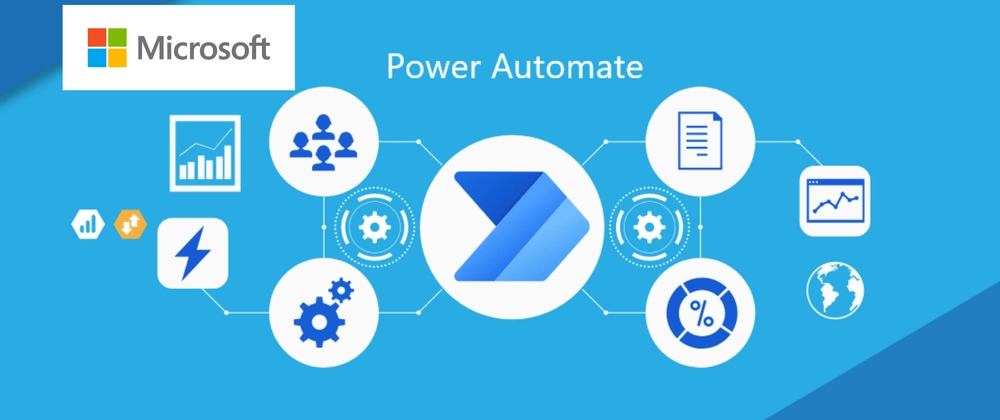Power Automate is a tool by Microsoft that lets you automate repetitive tasks across your computer and cloud apps — without writing code.
It comes in two versions:
A) Power Automate (Cloud) – automates tasks between services like Outlook, Excel, Teams, Google Drive, etc.
B) Power Automate for Desktop (PAD) – automates tasks on your local computer, like opening apps, organizing files, clicking buttons, or filling out forms.
As we all are very busy in our lives, automation will surely help us to catch a break. To automate your daily lives, Power Automate by Microsoft will work like a charm. In this tutorial, we'll focus on Power Automate for Desktop (PAD). Here is a list of use cases of PAD:
1) File & Folder Organization
Automatically move, rename, or sort files in your Downloads or Documents folder based on type, date, or name.
2) Break Reminders & Daily Notifications
Show pop-up messages at scheduled times (e.g., every 2 hours) to remind you to take breaks, hydrate, or refocus.
3) Time Tracking & Activity Logging
Track how long you use certain apps (e.g., Word, VS Code) and log the usage to a file for productivity analysis.
4) Automate Routine Daily Tasks
Schedule PAD flows to run automatically at specific times (like launching your planner at 7 AM or logging reflections at 10 PM), so your day starts and ends with focus — without you doing anything manually.
5) Clipboard & Text Automation
Monitor what you copy, log it to a file, or turn it into quick notes — perfect for saving research highlights or repetitive text snippets.
In this tutorial, I will show you how to do all of these in Power Automate for Desktop.
But first,
System Configuration:
Windows Operating System
Windows 10 (Pro, Enterprise, or Education) or 11Install Power Automate for Desktop
Download from the official Microsoft site:
Microsoft Account (Optional but Recommended)
Needed if you want to:
Sync with Power Automate cloud flows
You can still use PAD locally without logging in
- Internet Connection Required for installation, updates, and integration with cloud services
Not needed for running offline desktop flows (like file organization, launching apps, etc.)
Tutorial 1: File & Folder Organizer
In this tutorial we’ll build a File & Folder Organizer that automatically cleans up your Downloads folder by moving files into categorized folders based on their file type.
📄 PDFs → Documents\PDFs
🖼️ Images → Pictures\Screenshots
🗜️ ZIP/EXE → Downloads\Installers
STEP 1: Create a New Flow
- Open Power Automate Desktop
- Click New Flow
- Name it: Organize Downloads and click Create
STEP 2: Set the Source Folder
- Search: Get files in folder
- Drag it into the flow
- Set: Folder path: C:\Users\YOURNAME\Downloads File Filter: Only move images -> .jpg;.png;.jpeg Only sort PDFs -> *.pdf Only install files -> *.exe;.zip All files -> Leave blank or .
Include subfolders: ❌ (Uncheck)
Save to variable: DownloadedFiles
STEP 3: Loop Through Each File
- Search: For each
- Drag For Each into the flow
- Set: Value to iterate: %DownloadedFiles% Variable name: CurrentFile
STEP 4: Check File Type and Move
- Inside the loop, add "If" condition blocks to detect the file extension:
First operand -> Text.EndsWith(%CurrentFile%, ".png") OR
Text.EndsWith(%CurrentFile%, ".jpg") OR
Text.EndsWith(%CurrentFile%, ".jpeg") OR
Text.EndsWith(%CurrentFile%, ".zip") OR
Text.EndsWith(%CurrentFile%, ".exe")
Operator -> leave default (it becomes a full expression)
Second operand -> (leave blank — not needed in this format)
- Add the Move File Action Inside the If Block
- Search "Move File" and drag inside if block
- Fill in like this:
File to move: %CurrentFile%
Destination folder: C:\Users\YourName\Documents\PDFs (or Pictures\Screenshots, etc.)
STEP 5: Save & Test
- Click Save
- Run the flow with a messy Downloads folder 🎯
- Watch files move into their proper folders automatically!
Tutorial 2: Automate Break Reminders & Daily Notifications
Our automation will show a popup message every 1 hour during the day that reminds you to:
💡 "Time for a break! Stand up, stretch, drink water, and breathe."
Step 1: Create a New Flow
- Open Power Automate for Desktop
- Click New Flow (at left above)
- Name it: Break Timer Reminder nad click Create
STEP 2: Add a Loop to Repeat Forever
- In the left panel, search for "Loop condition"
- Drag it into your flow
- Fill in like this: [First Operand=1, Operator=equals, Second Operand=1]
This creates an infinite loop that keeps running until you stop it manually.
STEP 3: Add a 2-Hour Wait Inside the Loop
- Inside the loop, drag in the action "Wait"
- Set: [Duration: 3600, Unit: Seconds]
This will pause the flow for 1 hour before the next reminder.
STEP 4: Add the Break Reminder Message
- Drag the action Display message below the Wait, still inside the loop.
- Fill it out: [Title: Break Reminder, Message:💡 Time for a break!\nStand up, stretch, drink water, and breathe. Icon: Information Buttons: OK]
STEP 5: Save and Test Your Flow
- Click the Save icon (💾)
- Click Run ▶️ to test it
From here, it will wait 1 hour, then show the message forever — unless you stop the flow.
Done! You now have a personalized automated wellness assistant reminding you to take breaks!
These two tutorials are for today. In the next tutorial, we'll talk about the rest of the tutorials.
If you have any questions or feedbacks, let me know in the comments. Happy Learning!





Top comments (1)
Here's link to the part 2:
dev.to/coderanger08/power-automate...